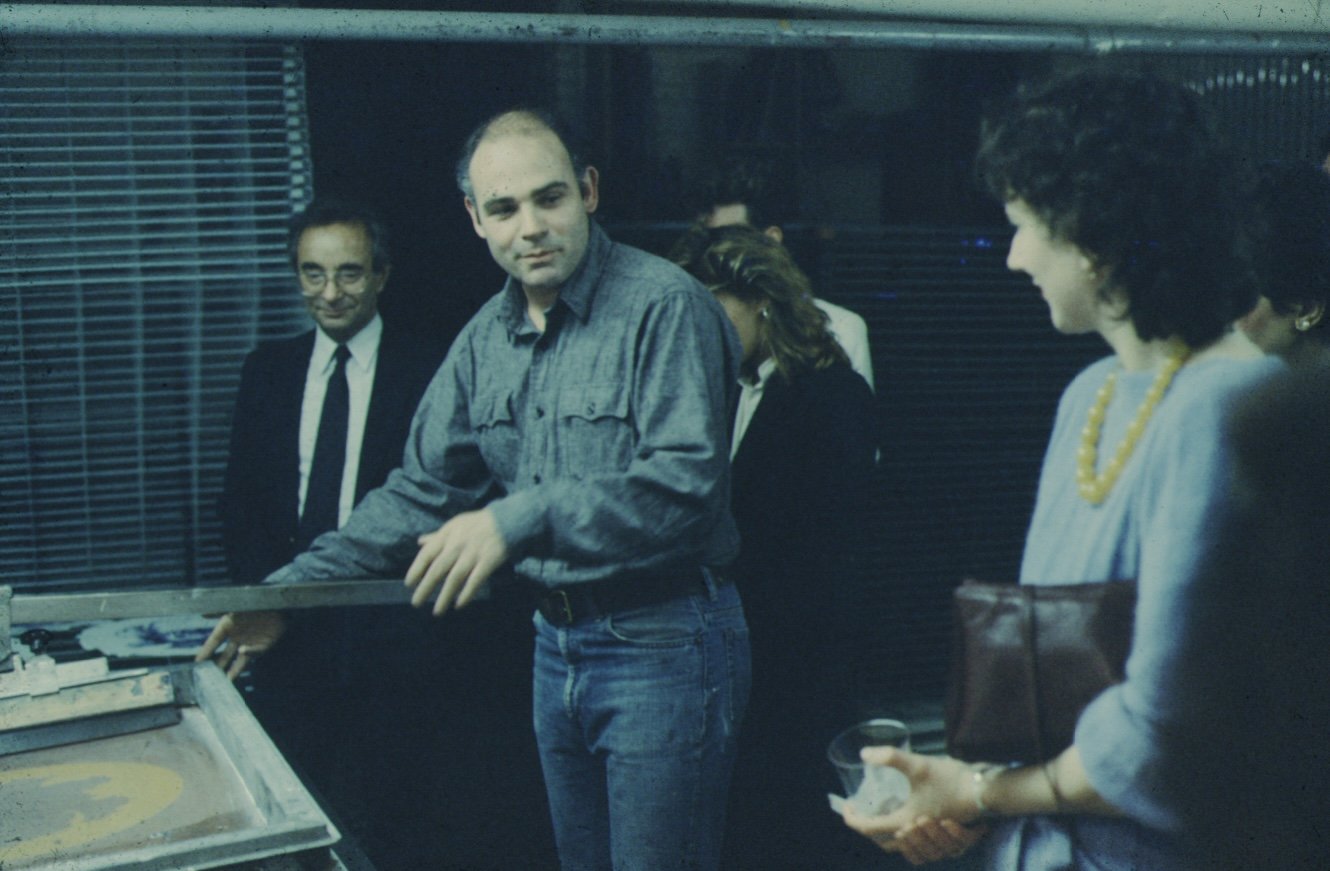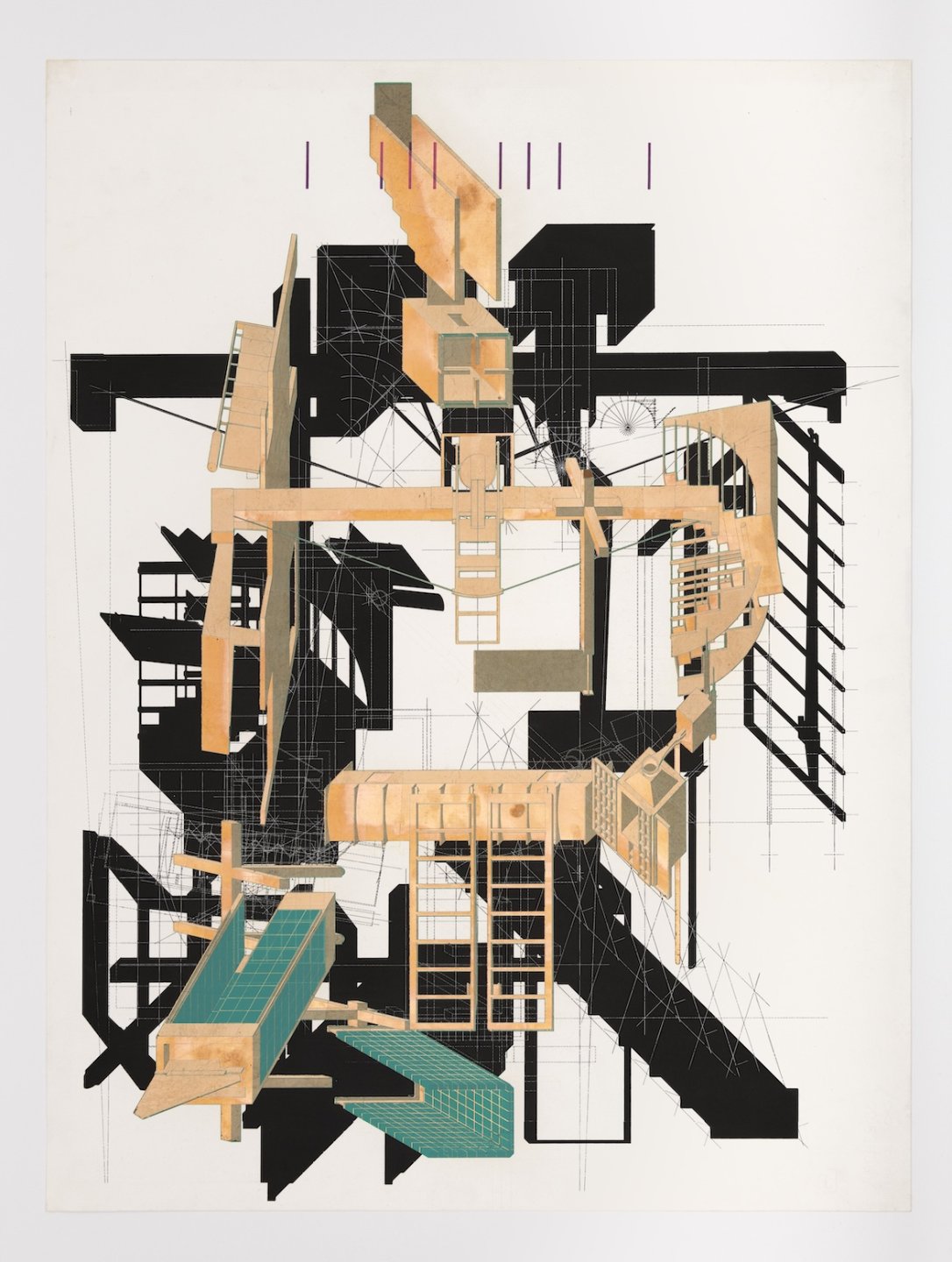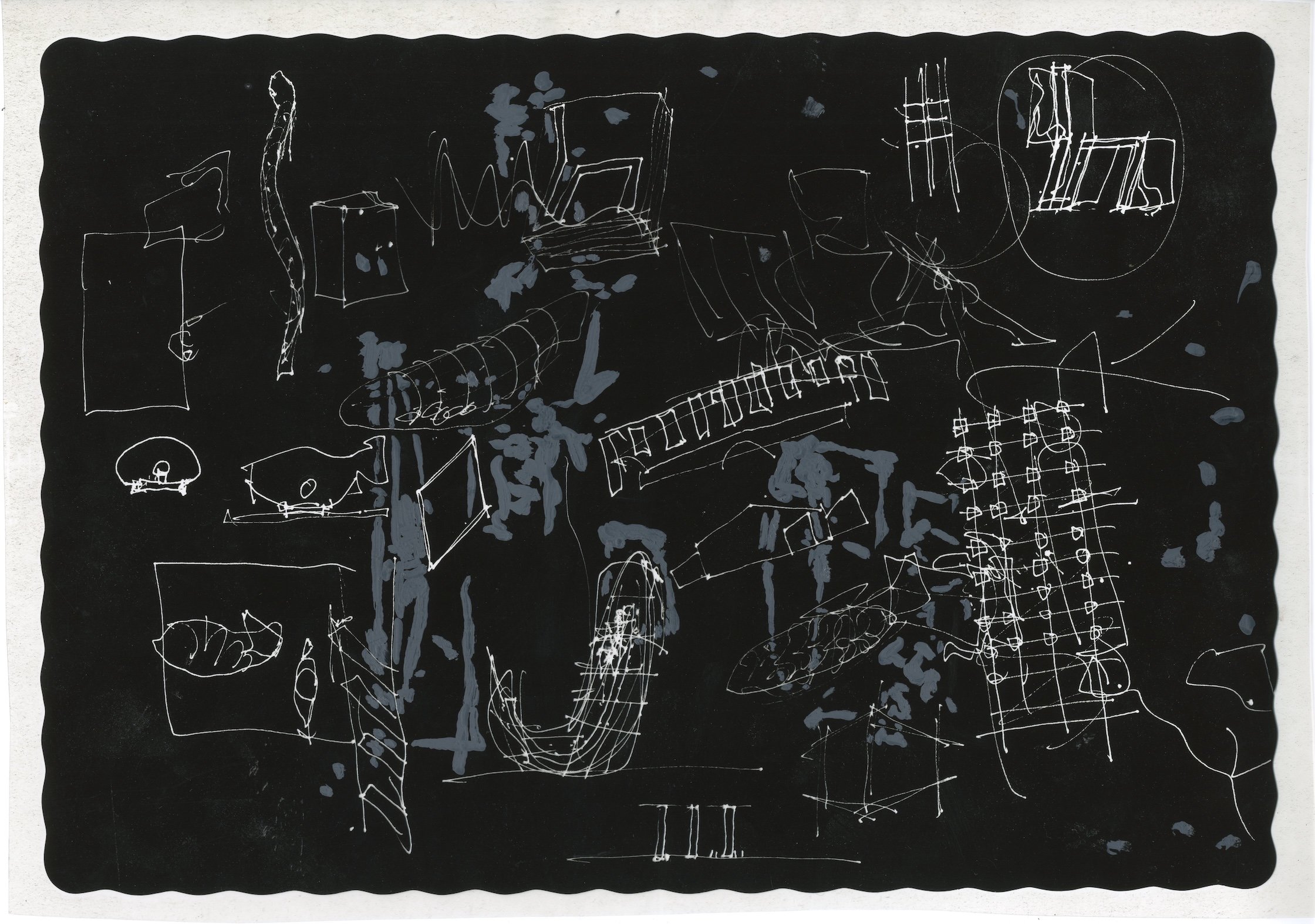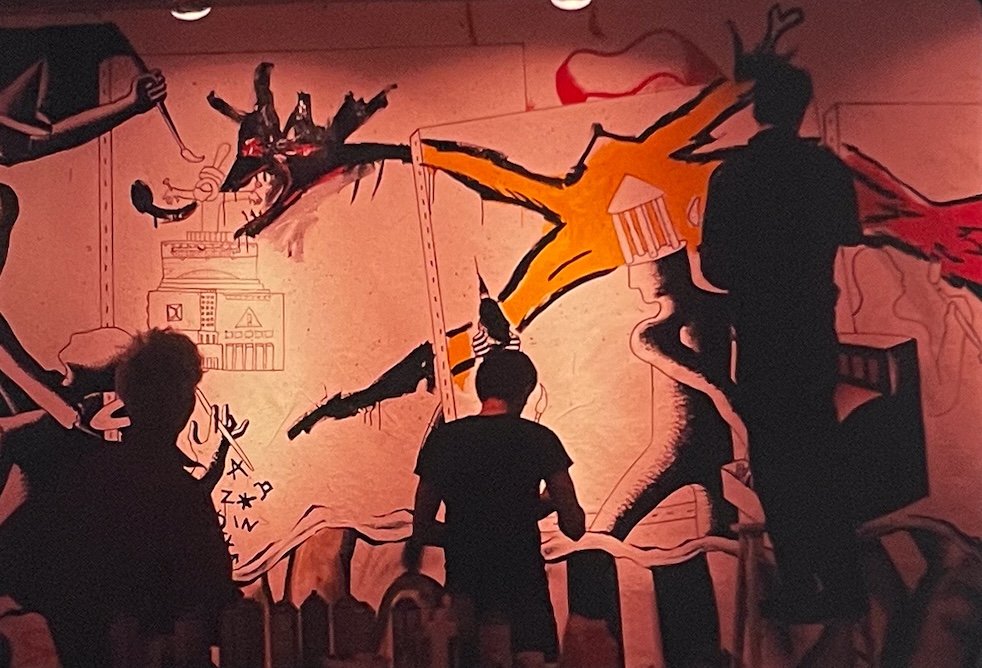
Before influencers crowded its cobblestone streets and upscale boutiques leased its cast-iron storefronts, SoHo was the epicenter of New York City’s art scene. Most of those spaces—the squats, studios, and experimental galleries that populated the neighborhood after factories pulled out during the postwar era—are long gone, but a few holdouts remain. One of them is a83, a nonprofit gallery, printshop, and archive located at 83 Grand Street. It’s an homage to, and a continuation of, John Nichols Printmakers & Publishers (JNP&P), a screen printer and exhibition space that occupied the same address from 1978 to 1994, during which time it shaped the visual communication of experimental architecture.
Working with architects including Thom Mayne, Steven Holl, Michael Graves, Charles Moore, Robert Venturi, John Rauch, and Denise Scott Brown, JNP&P’s editions were exceptionally beautiful and daring, printed with explosive colors and materials such as gold and copper, which no other studio could replicate. And the space was unique in the architecture scene—a rare meeting ground centered around industrial production where designers and artists would come to talk shop.
Remarkably, its output remains known mostly only to insiders. However, that’s changing: A new book on JNP&P’s legacy, out this fall from Spector Books, plus an ongoing series of contemporary and archival exhibitions at a83—which has been run since 2020 by John’s son Owen Nichols and his partner, Clara Syme, who are both architects—are reintroducing the studio and carrying on the conversations that began within its walls decades ago. All together, JNP&P’s incredible archive and its reincarnation as a83 reminds us of the experimentation and imagination that can only happen in the highly physical, hands-on world of printmaking.
“We see the historic work as a really significant piece of architecture that missed out on the internet and hasn’t been circulated in the same way that other movements of architectural representation have been,” Owen says. “We feel a responsibility to preserve and present it in a respectful way.”

Now, as it was back then, the gallery is at street level and the buzzing printing operation is in the basement, divided into three rooms: an office toward the front, a production area in the back, and between them an archive filled with more than a hundred flat files of signed editions, printer’s proofs, separation transparencies, test runs, and misprints.
The machines are the same, or the same models at least, that John operated: A risograph (an apparatus that’s like a cross between a screen printer and a photocopier) hums along while an etching machine with a five-foot-wide wheel stands in the center. Owen and Syme’s studio is more environmentally friendly, though, with water-based instead of oil-based inks, LEDs instead of eye-searingly bright carbon arc lamps, and better ventilation than John’s operation had. “You’d always come up a little high from working in that space,” recalls Jesse Reiser, an architect who collaborated with John in the 1980s.
Just like SoHo looks nothing like it did 40 years ago, the same is true of architectural images. First of all, there’s simply a lot more of them. With just a few clicks into CAD or a phrase typed into a generative AI model, it’s possible to create an endless scroll of architectural drawings and renderings in seconds. And although these are valuable tools, they’re a far cry from the methodical work of printmaking, a medium that, in the studio of JNP&P, was treated like architecture: a collaborative and iterative problem-solving process.
“You didn’t come into the shop and say, ‘I want this system. I’ll come back in two weeks,’ and then we’ll print something,” says John, who is now retired and resides in New Jersey. “What we were doing [was] becoming part of the architecture office that came in.”
He started teaching screen printing to architecture students at Princeton in the early ’90s and, after closing his SoHo space, continued to experiment—one year he spent his entire budget on computers, to the chagrin of the school’s dean—and move forward with his practice, not having the time to properly archive or digitize his body of work, which is now all at a83 and available to see by appointment. (Between the closure of JNP&P and opening of a83, the space was home to two art galleries, Collins & Milazzo, from 1994 to 2002, and Team Gallery, from 2006 to 2020.)
John was one of the few printmakers who was interested in and willing to work with architects. Trained as an architect himself, John moved from the San Francisco Bay Area to New York, in 1968. He landed in SoHo, where one of his first projects was renovating interiors in the old Baker Brush Co. factory, a building on Grand Street that stretched from Wooster to Greene and that had become live-work artist studios. Through this, he met Alexander Heinrici, a printmaker who produced Andy Warhol’s silkscreen paintings. The two struck up a friendship and soon John began to assist Heinrici, learning the art of screen printing. He was seduced by the medium and the world around it. “I thought of myself as an architect playing with artists,” he says.
In 1978, John opened his own live-work studio in the building. He initially collaborated with painters, but word got around that he was interested in exploring the precision architects could bring to their work as a publisher. Meanwhile, a generation of architects was imagining worlds meant to exist only on paper, where they wouldn’t be compromised by the realities of structural engineering, clients, and a grim economy that had all but wiped out commissions.
They relayed their ideas through projects such as Pamphlet Architecture, an experimental publication founded by Holl and William Stout in 1978 that featured the electrifying theoretical work of practitioners such as Lebbeus Woods and Zaha Hadid; and Storefront for Art and Architecture, the Manhattan gallery founded in 1982 to present a provocative, interdisciplinary critique of the built environment. They also entered design competitions, which were booming in the ’80s, and wanted to submit materials that would give them an edge and that they could duplicate.
Enter prints. While architects might learn drafting and drawing to communicate their ideas, the industrial production method of printmaking usually wasn’t in their repertoire. JNP&P became a place where architects who were operating like visual artists had the creative capacity to try something different. This included screen prints for Graves’s winning entry into SFMOMA’s 1985 competition for the Clos Pegase winery; place mats for Rebecca’s, the Los Angeles restaurant that Frank Gehry designed in the late 1980s; and serigraphs printed on latex for Elizabeth Diller and Ricardo Scofidio’s 1991 “Tourisms: suitCase Studies” installation.

Holl, who was among JNP&P’s first architectural clients, recalls how energizing it was to collaborate with the studio. “The thing that drove me to John Nichols was his enthusiasm,” he says. “He was an amazing figure in terms of [his] enthusiasm for the work. As Le Corbusier said, We all need to nourish a sense of play. I felt every time I went to the printmaking studio there was a sense of experimentation, joy, play, and humor. It was very special and made the whole process something rare and to be cherished.”
John incorporated artist techniques he worked with—for clients including Laurie Anderson and Joseph Beuys—into prints he made for architects, and applied what he learned from one project to the next. The metal leaf he used in a print of Mayne’s Sixth Street Residence became a hallmark of Morphosis’s images, but it’s something that John and Gordon Hart, an artist known for playing with color and texture, developed. “These two authors don’t have anything to do with each other, but techniques from the print studio end up formally influencing them both,” Syme says.
Abbott Miller, a graphic designer and partner at Pentagram, worked with JNP&P on a series of posters for the Princeton School of Architecture in the early ’90s. He was impressed with the studio. “I remember thinking, this is the architecture world behaving like the art world,” says Miller, who appreciated working alongside a master printer. “Once you get hooked on fancy silkscreen printing, it’s sort of narcotic,” he continues. “John’s prints looked like they had painted surfaces—it was almost like a stand-in for the materiality of something built. You can achieve a kind of complexity in standard offset printing just by virtue of the image, but you never get the magical tactile layering that you get in silkscreening.”
Reiser, who was in his late twenties when he worked with John, recalls the wild experiments that happened in the studio and how most of the conversations that took place were technical—how to achieve a certain visual effect, mixing colors, what would happen if they sprinkled metal dust into the photosensitive emulsion—which was different from the architecture banter at cocktail parties and openings.
“It was shop talk,” Reiser says. “If you talk to serious artists, that’s what they do. Good jazz musicians don’t talk about content; they talk about technique.” This was what John seemed to enjoy the most, too. Reiser remembers the phone constantly ringing and overhearing commercial clients asking about overdue projects. “He would ignore money-making clients and just totally get into technique and experiments, and we benefited from that.”

The in-person nature of the work over weeks and months was an anomaly, too. “The sustained contact is really important,” Reiser adds. “The workshop was open and it was a community. People would just drop in. Everyone was checking each other out. It was competitive in a really good way.”
Eventually, that competitiveness extended to which architects got to work with JNP&P. Both Holl and Mayne entered a 1988 competition to design a library in Berlin and wanted to submit screen prints. Holl recalls Mayne coming to the shop and catching a glimpse of the in-process project. “When he saw my silkscreens […] he sort of had a slack, sad look because he was aware we would win the competition,” Holl says. “He’s a close, dear friend, and I think he also enjoyed the enthusiasm of John Nichols.”
Because JNP&P’s business was built on publishing—not selling and showing—prints, its exhibition space took risks, showing work by architects that most galleries dismissed. (The studio was a go-to for architects who sold their work at Max Protetch Gallery, located five blocks away at the time.) Two such practitioners were Karen Bausman and Leslie Gill. “I still recall walking into the space when John bounded up the central staircase wearing his magnificently ink-stained printer’s apron and introduced himself,” Bausman says. “His support became crucial in ensuring our work’s continuation and evolution, particularly at a time when downtown gallerists struggled to understand the work of research-based architects and when women were frequently overlooked for exhibition space.” JNP&P hosted the pair’s “Interior Sightings” show in 1985, and printed an accompanying poster.
The gallery also became known as a place where architects could go rogue. Antoine Predock poured more than a dozen bags of sand into the space for his 1988 “Landscape Apparitions” exhibition. The work he showed was informed by the physics of windswept sand, and so he set up fans that would blow the material around, eventually burying architectural models he installed. “We really messed up the place,” John recalls. Owen says they still find sand there.
Today, the hands-on nature of printmaking is resonating with emerging architects once again. “It’s slower, it’s stickier—things go wrong,” Syme says of the medium’s complexities. “There’s more problem-solving involved. Choosing to use one color versus five actually has real ramifications. In the same way that architects like constraints for budget or material sourcing, that same thing applies for images now that it’s so easy to mass-produce them.”
Owen and Syme’s growing roster of collaborators has included MOS Architects, Sean Canty, and Adam Charlap Hyman. They also teach printmaking to architecture students at The Cooper Union.
Reiser is excited to see a new creative circle growing around a83. “It’s really important to the health of the architecture community in New York,” he says of its output. “Most of the work now happens in separate offices. Even though you have the internet and all of that communication, there’s something really important about embodied direct interaction to advance the discipline.”